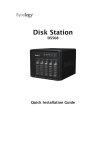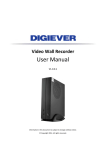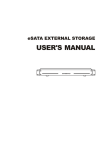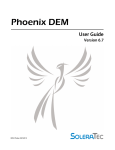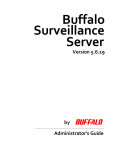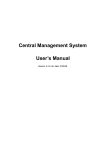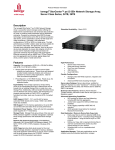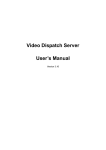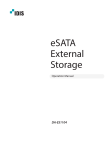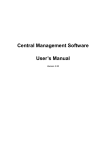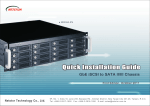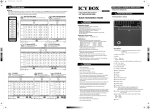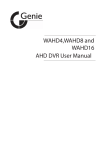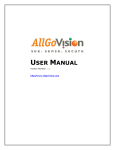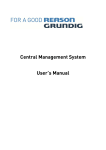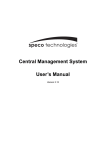Download 20 MB 14th Feb 2014 NVRPRO Manual
Transcript
NVRPRO Series Network Video Recorder User Manual Table of Contents 1. Introduction ................................................................................................ 4 1.1 Hardware .............................................................................................. 5 1.2 LED Indicators Status ......................................................................... 7 NVRPRO4 Series...................................................................................... 7 NVRPRO8 Series...................................................................................... 9 1.3 HDMI and VGA Connection............................................................... 11 2. NVR Installation ........................................................................................ 12 2.1 System Requirements ....................................................................... 12 2.2 Connect to NVR PRO......................................................................... 13 Quick Guide ............................................................................................ 13 Install NVR Search .................................................................................. 13 Install S-NVR Decoder ............................................................................ 21 User Manual ............................................................................................ 21 Browse CD .............................................................................................. 21 Activate Live View Service ...................................................................... 21 2.3 Quick Configuration ......................................................................... 25 3. Use NVRPRO with Local Display ............................................................ 39 3.1 Login NVRPRO NVR .......................................................................... 39 3.2 Live View ............................................................................................ 51 3.4 Playback ............................................................................................. 57 3.5 Others ................................................................................................. 63 4. Using the NVRPRO with Remote Web Browser .................................... 63 4.1 Live View ............................................................................................ 63 Select View Modes on Live View Page ................................................... 64 Main Functions for Live View .................................................................. 65 Multi-NVR Server .................................................................................... 74 4.2 Playback ............................................................................................. 75 4.3 Play Video Files ................................................................................. 86 5. Configuration ............................................................................................ 93 5.1 IP Camera .......................................................................................... 93 Camera Settings ..................................................................................... 93 Camera Search ....................................................................................... 98 Camera Parameter................................................................................ 100 Camera Status ...................................................................................... 103 5.2 Recording & Events ....................................................................... 104 Recording Settings ................................................................................ 104 Recording Schedule .............................................................................. 106 Event & Action Management................................................................. 110 Alarm Schedule ..................................................................................... 119 E-Mail .................................................................................................... 122 5.3 Disk Management ........................................................................... 125 Disk Management ................................................................................. 125 File System Management ..................................................................... 126 File Sharing Service .............................................................................. 127 5.4 Network Setup ................................................................................ 129 Network Setup....................................................................................... 129 Network Service .................................................................................... 131 DDNS .................................................................................................... 133 5.5 Management.................................................................................... 134 User Management................................................................................. 134 Log System ........................................................................................... 138 Save/Load Configuration....................................................................... 141 USB Backup .......................................................................................... 143 External IO Device ................................................................................ 145 5.6 System ............................................................................................. 147 Device Information ................................................................................ 147 System Upgrade ................................................................................... 148 Language .............................................................................................. 149 Date &Time ........................................................................................... 149 Buzzer ................................................................................................... 150 Reboot & Shutdown .............................................................................. 151 1. Introduction When you first open the product’s package verify that all the accessories listed on the “Package Contents” in the “Quick Installation Guide” are included. Before installing the NVRPRO, please read the instructions in the “Quick Installation Guide” to avoid misuse, and then follow the instructions in the “Hard Disk Installation” section to avoid causing damage due to faulty assembly or installation. 1.1 Hardware NVRPRO4 Series NVRPRO49/ NVRPRO416/ NVRPRO432 Front View 1. 2. 3. 4. 5. 6. 7. 8. 9. 10. 11. 12. 13. 14. 15. Rear View LED Indicators: LAN1, LAN2, eSATA, HDD1, HDD2, HDD3, HDD4 Power Button USB Backup Button - Auto Video Backup USB 2.0 x 1 (Support Auto Video Backup) USB 2.0 x 1 HDD1 HDD2 HDD3 HDD4 Gigabit LAN x 2 USB 2.0 x 4 eSATA x 2 (Reserved) VGA Output HDMI Output DI/DO (4 In 2 Out) Top to Bottom: Vcc5V, GND, DI-1, DI-2, DI-3, DI-4, DO-1, DO-2 16. Reset Button 17. Power Connector 18. K-Lock Security Slot NVRPRO8 Series NVRPRO816, NVRPRO832 Front View Rear View 1. LED indicators: LAN1, LAN2, eSATA, HDD1, HDD2, HDD3, HDD4, HDD5, HDD6, HDD7, HDD8 2. Power Button 3. USB Backup Button - Auto Video Backup 4. USB 3.0 x 1 (Support Auto Video Backup) 5. HDD1 6. HDD2 7. HDD3 8. HDD4 9. HDD5 10. HDD6 11. HDD7 12. HDD8 13. Gigabit LAN x 2 14. USB 2.0 x 4 15. eSATA x 2 (Reserved) 16. VGA Output 17. HDMI Output 18. DI/DO (4 In 2 Out) Right to Left: Vcc5V, GND, DI-1, DI-2, DI-3, DI-4, DO1, DO2 19. Reset Button 20. Power Connector 1.2 LED Indicators Status NVRPRO4 Series NVRPRO49, NVRPRO416, NVRPRO432 LED’s on the Front Panel LED LAN1 LAN2 eSATA HDD1 HDD2 HDD3 HDD4 Power Backup LED Status OFF Orange Indicates LAN Link is not established LAN Link is established Orange Blinking LAN activity is occurring OFF No data transmission Orange Blinking The eSATA device is being accessed OFF Hard disk drive device is not ready Green Hard disk drive is being accessed Red Hard disk drive error occurred. Blinks at 0.5Hz OFF Green Red Power Off Power On System error occurred OFF Blue USB device is not detected USB device is ready NVR data is being copied to the USB device. Blinks at 1Hz Backup error occurred Blue Blinking Red *USB BACKUP will start and beep after 3 seconds when the user presses the BACKUP button. **To turn the NVR Off, the user needs to press and hold the power button for at least 2 seconds. LED’s on RJ45 Connection on the Rear Panel LED LED Position LAN1 LAN2 Link/Activity (Right LED) LAN1 LAN2 Speed (Left LED) LED/State OFF Yellow Yellow Blinking OFF Green Orange Indicates LAN Link is not established LAN Link is established LAN activity is occurring 10Mbps connection or no connection 100Mbps connection 1000Mbps connection *USB BACKUP will start and beep after 3 seconds when the user presses the BACKUP button. **To turn the NVR Off, the user needs to press and hold the power button for at least 2 seconds. NVRPRO8 Series NVRPRO816, NVRPRO832 LED’s on the Front Panel LED LAN1 LAN2 eSATA HDD1 HDD2 HDD3 HDD4 HDD5 HDD6 HDD7 HDD8 Power Backup LED Status OFF Orange Indicates LAN Link is not established LAN Link is established Orange Blinking LAN activity is occurring OFF No data transmission Orange Blinking The eSATA device is being accessed OFF Hard disk drive device is not ready Green Hard disk drive is being accessed Red Hard disk drive error occurred. Blinks at 0.5Hz OFF Green Red Power Off Power On System error occurred OFF Blue USB device is not detected USB device is ready NVR data is being copied to the USB device. Blinks at 1Hz Backup error occurred Blue Blinking Red LED’s on RJ45 Connection on the Rear Panel LED LED Position LAN1 LAN2 Link/Activity (Right LED) LAN1 LAN2 Speed (Left LED) LED/State OFF Yellow Yellow Blinking OFF Green Orange Indicates LAN Link is not established LAN Link is established LAN activity is occurring 10Mbps connection or no connection 100Mbps connection 1000Mbps connection *USB BACKUP will start and beep after 3 seconds when the user presses the BACKUP button. **To turn the NVRPRO Off, the user needs to press and hold the power button for at least 2 seconds. *** The LED’s in the HDD trays are reserved for future use. 1.3 HDMI and VGA Connection NVRPRO4 and NVRPRO8 Series local display provides both HDMI and VGA video output interfaces. Users can connect to both HDMI and VGA at the same time for video out. Scenario A: If both monitors are Full HD (1920x1080), the video is displayed on both as Full HD. Scenario B: If both monitors are XGA (1024x768), both displays are XGA. Scenario C: If one monitor is 1920x1080 and the other is 1024x768, both monitors are set to 1024x768. 2. NVR Installation 2.1 System Requirements The following are the minimum system requirements for a personal computer to operate the NVRPRO: Operating System Microsoft® Windows® XP/ Vista/ 7 Browser Microsoft® Internet Explorer 7.0 or above (32-bit) CPU For under 16-channels: Intel® Dual core CPU 3.0 GHz or above. For over 16-channels: Intel® i5/i7 CPU 3.3 GHz or above. Network Minimum 10/100 Ethernet (Gigabit Ethernet is recommended) Note: * Users are advised to connect cameras and NVR with Gigabit switches. Memory For under 16-channels: DDR3 4G or above. For over 16-channels: DDR3 8G or above Graphics Adapter AGP or PCI-Express, minimum 1024768, 16-bit colours, 1G memory or above Note: It is highly recommended to use a graphics adaptor which provides higher than 1024 x 768 resolution in order to experience the full benefits of the software. Make sure the display DPI setting is set to default at 96DPI To set DPI value, right-click on desktop, choose “Settings” tab >> “Advanced” >> “General.” CD-ROM Drive It’s necessary to read the operating instructions on the provided CD-ROM. Adobe Reader It’s necessary to read the operating instructions in the provided CD-ROM. The audio function will not work if a sound card is not installed in the PC. Audio may be interrupted, dependent on network traffic. 2.2 Connect to NVR PRO To begin, please insert the product CD-ROM in a PC to access the Quick Guide, User Manual and to install the utilities. When the product CD is running, the following menu is displayed: Quick Guide Click “Quick Guide” to enter the folder and double click the file to open. Please read the Quick Guide to understand the NVRPRO installation process. Install NVR Search Click “Install NVR Search” to find the NVRPRO4/8 on the network. Please follow the instructions to install and the NVRPRO Search runs automatically. Install Shield Wizard window for NVRPRO Search pops up. Click “Next” to continue installation. Read the license agreement and click “I accept the terms of the license agreement”. Click “Next” to continue installation. Select a destination location and select a folder where the setup can install files. The default location is: C:\Program Files (x86)\NVR\NVR Search. Users can also install NVR Search in another folder by clicking “Change” and selecting a location as shown below. Click “OK” to save the setting. Once a folder is selected, click “OK” to continue installation. The window shows the Install Shield Wizard is installing NVR Search. Please wait until the Wizard completes the installation. The Install Shield has successfully installed NVR Search. Select “Create Desktop Shortcut”/ “Create Quick Launch Shortcut”/ “Create StartMenu Shortcut” and click “Next” to continue. The installation is complete. Please click “Launch application when done installing” to execute NVRPRO Search. After finishing the setup, the NVRPRO Search window pops up. Easy Search executes automatically and shows NO., Name, IP Address, Mac Address and Model name of the connected NVRPRO. Users can click “Search” to search for connected NVRPRO. EZ Search provides three kinds of toolbars for use by the user: 1. File You can click “Exit” to leave NVRPRO Search and close the window 2. Setting Configure UPnP and Network by clicking “Setting” (on the top left). Note: Users are prompted to enter the login information of the NVRPRO before being allowed to change the settings. When accessing the NVRPRO setting, users are prompted for the NVRPRO username and password. For first-time use the default username and password are admin/admin. When the correct username and password have been entered, click “Login” to continue. UPnP Universal Plug and Play (UPnP) simplifies the process of adding a NVRPRO to a local area network. Once connected to a LAN, the NVRPRO automatically appears on the intranet. You can rename UPnP Name for the NVRPRO. Click “OK” to finish the setting. Network Two modes are provided for setting the network: DHCP and Static IP. 3. Option Option provides twelve language options Once you click “Connect” or double click the selected NVR list, IE browser pops up automatically for the web-based interface. Install S-NVR Decoder “Install NVR Decoder” is no longer a required step as the “NVR Player” now contains the video codec required and installs this automatically during the installation progress. User Manual Click “User Manual” the user manual file to read. to open the folder and double-click on Browse CD Click “Browse CD” file. to open the folder of current Autorun.exe Activate Live View Service After setting the EZ Search, users can connect to the web-based interface by the following options: Connect to NVRPRO by NVR Search 1. Once you click “Connect” or double click the selected NVR list, the IE browser pops up automatically. 2. Enter username and password. For first-time use the default username and password are “admin/admin.” 3. Select the language for the User Interface. Allow ActiveX Control After logging in to the NVRPRO, users are recommended to install ActiveX control for the first-time installation. 1. Left-click on the description “This website wants to run the following add-on: ‘NVR ActiveX’ ” 2. Left-click on the description “Run Add on.” 3. Left-click “Run” to use licensed ActiveX controls. 2.3 Quick Configuration After you log in to the NVRPRO, and install the ActiveX control, the system directs you to setup the Quick Configuration (in five main steps). Follow the instructions of the Wizard Overview to complete the system setup. Start System leads you to select “Start” from the Configuration Utility drop-down menu to begin. To initialise the configuration, firstly study the Wizard Overview and the Wizard will guide you through five quick steps to set up the system. Click “Start” in Overview to begin Quick Configuration. Network Settings Select “Network Settings” from the Configuration Utility drop-down menu to begin. Users need to adjust the Network Setup page settings for the NVRPRO to work properly within the network. Obtain an IP address automatically (NVR Default) Obtain an available dynamic IP address assigned by a DHCP server. If this option is selected the NVRPRO automatically obtains an available dynamic IP address from the DHCP server - once it connects to the network. Specify an IP address. If no DHCP server exists in the network environment the static IP address 192.168.1.245 is given. It should be adaptable in most networking environments, and users can choose to maintain the default IP address or change it in this page. However, it’s advisable to set different IP addresses if there is more than one NVRPRO in the same LAN. To assign a static IP address to the NVRPRO: 1. Select “Specify an IP address” 2. Enter the IP address, Subnet Mask, Default Gateway IP Address and DNS server address. 3. If the IP Address is changed, users need to logout and login again. Click “Next” to proceed with the configuration. 2.3.1 Server Settings Select “Server Settings” from the Configuration Utility drop-down menu to begin. Server Name with UPnP Universal Plug and Play (UPnP) simplifies the process of adding a NVRPRO to a local area network. Once connected to the LAN, the NVRPRO automatically appears on the intranet. Users can select to enable the UPnP function and edit the server name. Password Settings Each NVRPRO comes with a built-in “admin” account with “admin” password. It’s highly recommended that the password is changed on the initial login. Enter a new password in the “New Password” field and enter it again in “Retype Password.” Once you confirm “Next,” the administrator password is changed. Date & Time Select “Date & Time” from the Configuration Utility drop-down menu to begin. Manual Setting Use the drop-down list and configure the time manually. Select the Year, Month, Date and Time. Time setting is effective when you click “Next.” Time Zone: Synchronise with an Internet Time Server automatically. Select the time zone for your area and automatically update the date and time of the NVRPRO with a NTP server. Users can also enable an option to automatically update for daylight saving changes. Configure the time and date by verifying and adjusting current local time and daylight saving to avoid the following errors: Incorrect display time on playback videos. Inconsistent display time of event logs and when they actually occur. Select to synchronise the server time with an Internet time server. NTP (Network Time Protocol) is a protocol for synchronising the clocks of a computer system. Enter the hostname of a valid NTP server. Built-in NTP Server in NVR NVRPRO provides the NTP server function for client device to synchronise the time clock. It helps maintain the same time schedule in your surveillance system. Disk Management Select “Disk Management” from the Configuration Utility drop-down menu to begin. When there are no hard disks installed in the NVRPRO, the page displays “Disk doesn’t exist.” Once a hard disk drive is inserted into the tray the Disk Information tab shows the device information and users can start to create new RAID Disks. Disk Information Device Information provides details of the hard disk drive: HDD Model, Serial NO., Capacity and Status. Create As the hard disk drive is available, the Device Information status shows “Ready”, which indicates the hard disk drive is ready to be created. Click “Create” to enter the window for building the New RAID Disk, and select the hard disk drive in the Free HDD’s field. The selected hard disk drive in the Free HDD’s field is highlighted in blue. Click to transfer the hard disk drive into the Assigned HDD’s field. The selected hard disk drive in the Assigned HDDs field is highlighted in blue. Meanwhile, Target RAID Disk is ready to build the RAID disk and shows the types of disk configuration options. Disk Configuration Big Drive (Linear) Performance (Raid0) Fault Tolerant (Raid1) Fault Tolerant (Raid5) Fault Tolerant (Raid10) Big Drive is a collection of hard disk drives and does not provide any RAID protection. Data is written to the disks continuously. RAID0 is one larger volume with 2 or more hard disk drives. Data is written to the hard disk drives without any parity information. The total storage capacity is the sum of all hard disk drives. 2 hard disk drives are required to create a RAID1 array. RAID1 can provide disk mirroring by duplicating the data between two hard disk drives. A minimum of 3 hard disk drives are required to create RAID5. Data is striped in all hard drives in a RAID5 array and the parity information is stored in each drive. If a hard disk drive fails, the array enters degraded mode. The data can be rebuilt from other member drives after installing a new drive to replace the failed one. Data is written in stripes across primary disks that have been mirrored to the secondary disks. A typical RAID 10 configuration consists of four drives, two for striping and two for mirroring Select a type of disk configuration, and click “Apply” to execute building a new RAID disk. Note: Don’t turn off the server or unplug any hard drives when RAID Disk is in building process. Please wait. The disk configuration is in a process. The progress is displayed “formatting….20%”. Please wait until it’s at 100%. The progress is at “Create swap” and is going to finish the disk building. Finally, the RAID disk building is complete. After the RAID disk is created, RAID List shows RAID Name and available storage devices. Device Information provides the hard drive status: RAID Name, Level, Capacity, Status-Active, Action State, Background Activity and Progress-none. Delete After the RAID Disk is created, a “Delete” option is available. If users are going to delete a RAID disk, please refer to the following: In the “Delete” option, users can remove, or format, RAID disks by selecting the RAID disk. In the table, RAID Name, RAID type, Capacity and Status are shown. Remove Click “Remove” to delete the RAID Disk. Once “Remove” is clicked, a window pops up to confirm the removal. To delete the RAID Disk, click “OK” to proceed. Please wait. The deletion is in a process. If users want to change the RAID level setting, please click ‘‘Remove.’’ After the RAID Disk is removed the status in Device information shows “Ready” and users can go back to the Create page to configure the new RAID level. Note: Once you remove the disk and recreate it, the recorded video will be formatted. Format Click “Format” to format the RAID disk. All recorded video is deleted. Once “Format” is clicked, a window pops up to confirm the command. To format the RAID disk, click “OK” to continue. Hard disk drive is formatting. Please wait until formatting is 100%. After the RAID disk is formatted, device Information status shows “active”. Camera Settings Please see Chapter 5 Configuration, 5.1 IP Camera. Finish Select “Finish” from the Configuration Utility drop-down menu to begin. Once the five step Quick Configuration is complete, the window shows the completed status. You can click “Back” to return to the previous steps to modify the configuration or click “Start Live view” to start monitoring. To review Quick Configuration settings or information users can also select “Quick Configuration” (top left of the Configuration main page). 3. Use NVRPRO with Local Display The NVRPRO can be connected to a monitor via the HDMI and VGA connectors to execute quick configuration and display live view. Note: The local display feature is supported by NVRPRO Series only. To start local display, please follow the steps below: 1. Install at least one hard disk drive in your NVRPRO. 2. Connect NVRPRO and IP cameras to the network. 3. Make sure the HDMI or VGA monitor is connected to the interface (HDMI or VGA) on the NVRPRO rear panel. 4. Connect a USB mouse to the USB port of the NVRPRO. 5. Connect the power cord to turn on the NVRPRO. 6. When you enter the login interface of the NVRPRO, enter default user name “admin” and password “admin” and select the local language. 3.1 Login NVRPRO NVR Users have to key in the correct username and password to login to the NVR. Resolution: Users can select the resolution 1920x1080 or 1024x768 in the login page, when the monitor supports both types of resolution. Anonymous login Anonymous login allows users to login without a username and password. Anonymous users can only view live monitoring and playback page in local monitor, and the configuration page is disabled. While an anonymous login is applied the system automatically logs in, after boot up, without the authorisation process. Start to setup the anonymous login A. Go to the user management page of the remote web browser, and go to Advance Settings. Check the “Enable Anonymous Access“. B. Enable the “Anonymous” at the local display login page, and then login. Virtual Keyboard Users can choose to use a USB keyboard for typing in the NVRPRO local display, or use the virtual keyboard. The virtual keyboard is enabled at the side of each column – see below. There are 3 types of virtual keyboard which can be selected - Upper Case, Lower Case and Symbols. 3.1 Quick Configuration After you login with a local display to the NVRPRO, the system directs you to set a Quick Configuration. Follow the instructions of the Wizard Overview to complete the system setup. Please refer to chapter 2.3 Quick Configuration for more information. Start To begin, study the Wizard Overview and the wizard will guide you through five steps to configure the system. Click “Start” in Overview of Wizard page to begin the Quick Configuration. Network Settings Obtain an IP address automatically Obtain an available dynamic IP address assigned by a DHCP server. Specify an IP address. The static IP address can be assigned. Click “Next” to proceed with the configuration. Server Settings Server name with UPnP Users can select to enable the UPnP function and edit the sever name. Once UPnP is enabled the NVRPRO can be searched on the intranet (LAN). Password Settings Each NVRPRO comes with a built-in “admin” account with password “admin.” It’s highly recommended the password is changed at initial login. Date & Time Manual setting Use the drop-down list and configure the time manually. Time Zone: Synchronise automatically with an Internet Time Server. Select the time zone of your area and update the date and time of the NVRPRO automatically with an NTP server. Click “Next” to continue configuration. Disk Management Disk Information Device Information provides details of the hard disk drive: HDD Model, Serial NO., Capacity and Status. Create As a hard disk drive is available, the Device Information status shows “Ready,” which indicates the hard disk drive is ready to be created. Click “Create” to enter the window for building a new RAID Disk, and select the hard disk drive in the Free HDD’s field. The selected hard disk drive in the Free HDD’s field is highlighted, click transfer the hard disk drive into Assigned HDD’s field. to The selected hard disk drive in Assigned HDD’s field is highlighted in blue. Select a type of disk configuration, and click “Apply”. After the RAID disk is created, RAID List shows the RAID Name and available storage devices. Delete In the “Delete” option users can remove, or format, a RAID disk. Remove If users want to change the RAID level setting, click "Remove." After the RAID Disk is removed the Device information status shows “Ready”. Users can return to the Create page to configure the new RAID level configuration. Format Click “Format” to format the RAID disk. All recorded video is deleted. Camera Settings Camera settings Two options for adding a new camera are provided. 1. Camera Search 2. Auto Detection 1. Camera Search: Click “Search” to find the UPnP devices within the LAN. Add cameras by clicking “+” from the list one by one. Users should manually enter Camera Name, User Name, and Password. Then click “apply” to submit the settings. Applied cameras will be shown in the Camera List. 2. Auto Detection: Manually enter the Camera Name, IP Address, User Name, Password and select the vendor or Auto, then click “Apply” to start connecting to the IP camera. All applied cameras will be shown in Camera List. Click “Next” to proceed. Generic RTSP/ Generic MJPEG NVRPRO NVR provides the interface for users to enter the RTSP/ MJPEG URL’s of IP cameras in order to receive the video streaming from them. The streaming can be used in live view, recording (recording) and playback. Generic RTSP and Generic MJPEG functions can be selected in the vendor list of the camera setting page. Continue by entering the Generic URL column with the correct RTSP or MJPEG URL’s. If Generic RTSP method is selected, the RTSP port should be filled out too. Click “apply” to submit the settings. The correct URLs should be provided from each camera vendors. Users may also refer to websites - https://www.soleratec.com/rtsp/` - http://www.ispyconnect.com/sources.aspx Finish Once the five step Quick Configuration is complete, the window shows a completed status. 3.2 Live View After the Quick Configuration is complete, users can successfully monitor IP cameras. In the live view page, users can monitor cameras in various display modes and control PTZ cameras. Firmware version Users can see the firmware version in the live view page On the top right of live view, users can select four different view modes. Mode Description Live View: Click “Live View” to view live video feeds. Playback: Click “Playback” to playback and export the recorded video files. Configuration: Click “Configuration” to configure camera, recording, event, management, network, quick configuration and system. Logout: To leave the NVRPRO click “Logout.” Display Mode The NVRPRO supports multi-display monitoring modes. Click the display mode icon to monitor live view. When you click a display mode the icon turns blue. Icon Description Full Screen 1 Screen 4 Screens 9 Screens 12 Screens 16 Screens 20 Screens 25 Screens 5+1 Screens Sequential Mode Icon Description Play: Start monitoring. Stop: Stop monitoring. Drop: Drop the camera from monitoring. Drop all: Drop all cameras from monitoring. Warning frame A red warning frame is shown on the channel when a motion event is detected. When the motion event is highlighted simply click on the channel with a mouse and the warning frame is removed. Warning frames can be enabled/disabled, refer to Chapter 4. 1.2 PTZ Control Panel If the IP camera supports PTZ function, users can use the control panel to adjust the viewing angle. The following functions are available - depending on the camera models. Icon Description PTZ Panel: A PTZ allows users to monitor large areas with a single network camera. Pan, tilt, and zoom functions can be controlled remotely. If the device supports PTZ control, users can click on the arrows to pan and/or tilt the camera. The house icon in the middle takes you back to the original monitoring position. Preset Positions: Select the preset positions which are defined in the PTZ camera and the camera moves to the position selected. Optical Zoom Out/ Optical Zoom In: If a camera supports PTZ control, adjust the PTZ camera to zoom out or zoom in. Schedule for PTZ: Select “Set” to set camera preset position. It opens the dialogue box for setting how many times PTZ repeats and how many seconds to stay between each preset point. Schedule for PTZ: Click “Go” to start PTZ patrol schedule. Exchange Streaming Type NVRPRO allows users to setup dual streaming configurations in the camera parameters page (if cameras support dual stream). It is suggested stream 1 is set for a higher resolution than stream 2. To switch to a different streaming option users can select the channel in the live view page and right click the mouse to have the options displayed. When “Optimize” is enabled, the streaming type is adjusted automatically in different display modes If “Optimize” is disabled, the streaming type can be adjusted and memorised for different display modes Snapshot of live view in local display Snapshot in live view allows users to capture the live view image in local display. The snapshot image can be found in the folder – Public/liveview_snapshot, and be accessed through Windows Networking or FTP service at File Sharing service in the Configuration page. CPU Loading Indicator CPU indicator in live view assists users in knowing the CPU loading. CPU indicator shows blue when the CPU loading is under 70%, and shows red, as a warning, when it’s over 70%. Changing the video configuration, like resolution, FPS and video quality or changing RAID type can influence the CPU loading. < under < over 3.4 Playback Playback is a function allowing users to view recorded videos from cameras connected to the NVRPRO. NVRPRO offers synchronised playback of up to four cameras and easy steps are provided to help users quickly sort through the recorded video. Steps to Search Playback Videos Select cameras Up to four cameras can be selected to playback the recorded video. Select time period: Users can designate the specific time for the video playback. If the selected cameras have recorded videos in the indicated period of time, dates are shown with a blue background. Select the type of recorded videos: There are four types of recorded videos: Normal, Event, Video Clip and Recovery. After selecting the video type and time period, click the play button to start playback. View Playback Videos The screen shows the recording time of each channel in the top of each grid. Click to view the video in full screen. One-screen and four-screens are also provided to display playback. Digital zoom in and digital zoom out The image can be enlarged by clicking digital zoom-in button. The image can be returned its previous size by clicking the digital zoom out button. Video play speed control 1 2 3 4 1. Play: Click the button to play video file. 2. Speed down: When you click “speed down,” the recorded video will play at slower speeds. 3. Pause: To temporarily stop the playback. 4. Speed up: When you click “speed up,” the recorded video plays faster. The play speed is displayed above the seek bar. Seek Bar By moving the seek bar, users can go directly to a specific recording time. Date and time are shown above the seek bar to provide a time reference. Playback Audio The audio is played according to the channel selected on the screen. Volume adjustment After channel selection, adjust the volume using volume button. Audio mute The mute function disables audio for all playback channels. Export Files The Export function allows users to export files directly to a USB drive. Select cameras, video file types, date and the time period first, and then click the export button to copy the files. Users are asked if the NVR Player and NVR Check should be downloaded with video files. NVR Player is the player for watching recorded NVRPRO files. NVR Check is the verification tool to verify if the recorded files originated from NVRPRO. Users can check the start time, end time and capacity before exporting the files. If the export is successful, the message shown above is displayed. Snapshot of Playback Users can take a snapshot while having the playback in local display. It needs a USB drive plugged in for the export of snapshot images and will take 10 sequential images, which are saved on the USB dongle. 3.5 Others Screenshot in Local Display The image of the full screen in local display can be saved in the NVR HDDs. The image is saved in the folder “Public “ and users can access the folder from remote web browser. User can access the file by the Windows Networking and FTP Service. Note: To use Windows Networking and FTP Service, enable both in “File Sharing Service” in the configuration page. Refer to chapter 5.3.3 4. Using the NVRPRO with Remote Web Browser Users can use Microsoft Internet Explorer to monitor the network camera and view playback. 4.1 Live View After the Quick Configuration is complete, NVRPRO guides you to live view. Users can view the live video stream from an IP camera via the network and monitor the view remotely. Live view displays the video according to the camera list which has been created in the Quick Configuration camera settings menu. Select View Modes on Live View Page On the top right of live view, users can select four view mode options. Mode Description Live View: Click “Live View” to view live video. Playback: Click “Playback” to play, and export, the recorded video files. Configuration: Click “Configuration” to configure camera, recording, event, management, network, quick configuration and system. Logout: To leave the NVRPRO click “Logout”. Main Functions for Live View Firmware Version: Users can see the firmware version without going to the configuration page. The function of each button is briefly described below: Camera status: Icon Description Camera name: The name of the camera is located in the top left corner in each video window. Users can rename the camera via the path “Configuration->IP Camera->Camera Settings.” Video compression format: M-JPEG/MPEG-4/H.264 Audio: If camera supports audio, NVRPRO displays audio in blue. Vice versa, NVRPRO shows audio in grey. Event: When event happens, NVRPRO shows warning to user for instant alert. Recording status: The window shows if the camera is recording or not. Desired grid: The outline border surrounds the desired window grid to highlight the image focus. Right click video window: Mute: To mute the audio of the video Video Size: Original or Fit Streaming change: To exchange the streaming resource. Go To Web: Go to camera configuration page. Go to NVR’s Setting Page: Go to NVR’s configuration page. Go to Playback: Go to NVR’s playback page. Go to Camera Web, Go to NVR’s Setting page and Go to Playback can be also be used while multiple NVR’s are connected. Display mode The NVRPRO supports multi-display monitoring modes. Click the display mode icon to monitor live view. When you click a display mode the icon turns blue. Icon Description Full Screen 1 Screen 4 Screens 9 Screens 10 Screens 12 Screens 16 Screens 20 Screens 25 /30/ 36 Screens 5+1 Screens 7+1 Screens 12+1 Screens Sequential mode Click to choose the page of liveview . In option, User can set the sequential interval, in userdefined seconds, for display mode. Basic function: Icon Description Cameras list: The camera status is enabled/ dropped in live view. Play: Start monitoring. Stop: Stop monitoring. Drop: Drop the camera from monitoring. Drop all: Drop all cameras from monitoring. Zoom out / Zoom in: Select a channel to enable digital zoom function. Camera information: Consists of Camera Name, IP address, bit rate, and status. Remote IO: Click to check camera DI/DO control for its input and output pins. Snapshot: Click on the “Snapshot” to save snapshots. Then, a window pops up to display the image. There are three functions for snapshot: 1. Clipboard: Copy the image to device’s temporary memory. Users can paste images to graphics painting programs, such as Paint, for advanced editing. 2. Save: Save image to default path. 3. Cancel: Cancel snapshot. Option: 1. General: Dynamic sort: Users can enable a dynamic sort to rearrange video feeds, in order, without having any blank grids after a video feed is dropped from live view. Resize all video images at all time Users can right click on the video and set the video size to original size or to fit the grid at all times. Highlight video window when event is triggered The check box for “Highlight video window when event is triggered” enables a warning frame which pops out for the channel where an event is detected. 2. Multi-Server: Users can save the camera list for multi-server in the live view page. 3. Sequential Mode Setting: Click the sequential interval tabs to set the number of user-defined seconds to be used for sequential mode. 4. Joystick Users are able to control PTZ cameras with a USB joystick. Choose the joystick tab, select the joystick model and then click ‘‘Apply’’ Joystick work with PTZ cameras if the status bar shows the PTZ icon. PTZ Control Panel If the IP camera supports PTZ functions, use the control panel to adjust the viewing angle. The following functions are available - depending on the camera models. Icon Description PTZ panel: PTZ allows users to monitor large areas with a single network camera. Pan, tilt, and zoom functions can be controlled remotely by users. If a device supports PTZ control, users can click on the arrows to pan and/or tilt the camera. The house logo in the centre takes you back to original monitoring position. Preset positions: Select the preset positions which are defined in the PTZ camera, and the camera moves to the position selected. Optical zoom out/ Optical zoom in: If a camera supports PTZ control, adjust the PTZ camera to zoom out or zoom in. Schedule for PTZ: Select “Set” to set camera preset position (reserved). It opens the dialogue box to set how many times the PTZ schedule is repeated and how many seconds to stay between each preset point Schedule for PTZ: Click “Go” to start PTZ patrol schedule. Exchange Streaming NVRPRO allows users to setup the dual streaming configurations in the cameras parameters page - if cameras support dual stream. It is suggested stream 1 is set as the higher resolution and stream 2 the lower. To switch to a different stream, select the channel in the live view page and right click the mouse to have the list displayed. When “Optimize” is enabled, the streaming type is automatically adjusted for different display modes. When “Optimize” is disabled, streaming type can be adjusted and memorised for different display modes Dewarp for fisheye cameras By right clicking on the video, users can select the correct dewarp engine for the fisheye camera. a. Choose mounting type b. Choose dewarp Type CPU Loading Indicator The CPU indicator in live view lets users to know the CPU loading. CPU indicator shows blue when the CPU loading is 70% or under, and shows red as warning when it reaches above 70%. Changing the video configuration - like resolution, FPS and video quality or changing RAID type influences the CPU loading, so users can find the best balance. < under 70%> < over Multi-NVR Server Users can add multi-NVR server by clicking “Searching NVR.” Insert the account and password of the NVRPRO which you are adding to the local server, and then the located NVR in the LAN appears; including the local NVR. Click up to 144 channels to add them to the camera list. Click “Ok” to add cameras or rescan to search for the NVR again. Add Server With correct IP, port, username and password, then click OK to apply, NVRPRO’s can be manually added in WAN or LAN. 4.2 Playback Playback is a function that allows users to view recorded videos from cameras connected to the NVRPRO. The NVRPRO offers synchronised playback of up to four cameras and easy steps are provided to help users quickly sort through the recorded videos. Playback video can be viewed in full screen and snapshots can be taken and saved during a video playback. Steps to Search Playback Videos Before viewing the recorded videos, two buttons “Search” and “Preference” are available to search the recorded videos. Search: Click the button to open recorded videos and refer to the instructions below: Preference: Select and set the snapshot path and format (BMP or JPG). Also the storage path for downloading the recorded files. Follow the four steps detailed below to quickly search the recorded video: 1. Select date from the calendar. 2. Select normal, event or recovery file 3. Select the channel number. 4. Select the video from the timetable. 1. Select Date from the Calendar Select the date to search for recorded video. Select a date that provides recorded video; the date is highlighted in blue 2. Select Normal, Event or Recovery file Users can select the video file type. Different colours are used in the timetable in order to distinguish between the types of video file. 3. Select the Channel Number Select the channel number to search the recorded videos. Up to 4 channels can be selected at the same time. 4. Select Video from the Timetable After selecting date, video file types and cameras, users can select the time period of video files and the results are highlighted in grey boxes in the timetable. Different recording types can be presented in different colours in the playback calendar in the remote browser. If there is only normal recording in the specific date, the date will be highlighted in blue. If there’s event recording in the specific date, the date is highlighted in blue with red stripes on each side. Users can also move the bar to enlarge or narrow down the time period to check for video files from the timetable. After selecting the video files and time period, a selection box shows the information you selected. Finally, click “Ok” to start playback. Thumbnail in Playback With thumbnail function in the playback, users can move the pointer of the mouse to the footage and the snapshot of the specific time is shown. It helps users to easily locate the period of time to play the recording file. From the thumbnail, users can also read the related information such as date, time and camera name. The thumbnail will be shown while the pointer moves on the footage View Playback Videos The screen shows the recording time of each channel in the top of each grid. Click to view the video in full screen. Single-screen and quad-screen are also provided to display playback. You can select different buttons to play the videos: 1 2 3 4 1. Play: Click this button to play the video file. 2. Speed down: When you click “speed down,” the recorded video moves slower and the minimum speed is 1/32x. 3. Pause: To temporarily stop the playback. 4. Speed up: When you click “speed up,” the recorded video moves faster and the maximum speed is 32x. Snapshot You can save the playback image by clicking “Snapshot” . Before taking snapshot from the NVRPRO we recommended you set the snapshot path in “Preference” . Dewarp for fisheye cameras By right clicking on the video you can choose the correct dewarp engine for a fisheye camera. a. Choose the dewarp engine: b. Choose the mounting type c. Choose the display mode Sequential snapshot in remote playback Users can have sequential images from the recording video while in playback. This helps users to catch the key frame in the recorded files. It can be setup for up to 5 sequential snapshots. Change the OSD colour Users can select different OSD colours. 1. Click “preference” 2. Click OSD colour setting button, select the OSD colour and click “OK” 3. Then all OSD colours are shown as per the selection. Change the OSD Font Size The OSD font size can be changed. Export Files The Export function allows recorded files to be retrieved from the server. Select the Storage AVI Path From the playback setting page, users can indicate the path where exported files, NVR Player and NVR Check are to be saved. Select by cameras and the time range Users can indicate which cameras and what time range is to be exported to the recording file. Start to export files from the NVRPRO By pressing the Export button, the Export process will start. NVR Player and NVR Check are also downloaded with the video files. NVR Player is the player for the NVRPRO recording files. NVR Check is the verification tool to verify if the recorded files originate from a NVRPRO. To cancel the transfer. Users can cancel the files transfer while downloading files from the NVR. 4.3 Play Video Files User can access the video files with Windows Networking and FTP Service. Note: To use Windows Networking and FTP Service, please enable both in “File Sharing Service” on the configuration page. By using the link button on the file sharing service page, users can open the dialogue box directly after the service is enabled. Windows Networking Through Windows Networking, users can search the video files by choosing a NVRPRO or entering an IP address to search from the Windows Start menu. Choose a Computer or NVRPRO Go to the “Network” folder and choose NVRPRO. If more than one server exists in the network, “Network” folder displays all servers. Note: The name of each connected NVRPRO is derived from the “Mac Address” of each NVRPRO in system information and follows the “Computer Name” in network information. Users can refer to “System” > “Device Information” > “System Information” in the configuration page to acquire the Mac address. “Computer Name” is shown in “Network” > “Network Setup” > “Information” in the configuration page. For example, the computer name is NVR005043000203. Thus, user can select a NVRPRO in the Network folder by this computer name. As you select a NVRPRO, a window pops up to ask you to enter the network password. If you haven’t amended the user name and password, please enter the default ones: After you enter the correct user name and password, the NVRPRO displays the folder “Public” and “videodata1.” Please select “videodata1” to check the video files. After entering “videodata1,” the folder displays the RecordFolders chronologically by recording dates. Select a folder to enter. All video files are listed chronologically, by recorded time and video length, each chunk is five minutes. Select a video file to play. Enter IP Address to Search Enter a NVR IP address from the Windows Start menu. After you enter the IP address, a window will pop up to ask for the network password. If you haven’t amended the user name and password, please enter the default ones: “admin/admin.” After you enters the correct user name and password, the NVR folder displays the folder “videodata1.” Select a RecordFolder and a video file to play. FTP Service To access the FTP service in a web-based interface, open Windows Internet Explorer and enter the NVR IP address which has been configured. After you enter the IP address, a window will pop up to ask for the user name and password to login to the FTP server. If you haven’t amended the user name and password, please enter the default ones: “admin/admin.” Please click “Log On” to proceed. The folder displays RecordFolders chronologically; by recording dates. Please select a folder to enter. All video files are listed chronologically, by recorded time and video length, each chunk is five minutes. Select a video file to play. 5. Configuration In the configuration page you can configure Quick Configuration, IP Camera, Recording & Event, Disk Management, Network Management and System from each drop-down menu. Note: The NVRPRO automatically logs out from the configuration page after being idle for 10 minutes. 5.1 IP Camera Camera Settings Camera settings The NVRPRO provides two options for adding cameras. 1. UPnP Search 2. Detect Detect: In this option you should enter the Camera Name, IP Address, User Name, Password and select vendor or Auto. Then click “Apply.” When an error occurred when entering the above information a notification window will pop up. If an inappropriate address is entered, a window pops up, as shown below. If an inappropriate user name is entered, a window will pop up, as shown below. When an inappropriate password is entered, a window will pop up, as shown below. After the detection is complete, the camera list shows the connected cameras showing the Camera Name, IP Address, Port, Vendor and Mode. All applied cameras are shown in the Camera List and if no more cameras needs to be connected click “Next” to continue configuration. If any camera requires deletion from camera list, click the column which will then turn blue and click “Delete.” A window will pop up to confirm the deletion. To delete the camera, click “OK” to proceed. Please wait. The deletion is in a process. The camera has been deleted from camera list. Generic RTSP/ Generic MJPEG The NVRPRO provides the interface for users to enter the RTSP/ MJPEG URL’s of IP cameras to receive their video streams. The streaming is applied to monitoring, recording and playback. Generic RTSP and Generic MJPEG functions can be selected in the vendor list of the camera setting page. Enter the Generic URL column with the correct RTSP or MJPEG URL’s. If Generic RTSP is selected, the RTSP port should be filled out too. Click “apply” to enable the parameters. The correct URL’s should be provided for each camera vendor. Users can also refer to websites - https://www.soleratec.com/rtsp/` - http://www.ispyconnect.com/sources.aspx Camera Search Click “UPnP Search” to find out UPnP devices within the LAN. Please wait. The UPnP search is in a process. The available cameras in the network will be displayed. Add any camera you want by clicking “Add” from the list one by one. After the search, the window displays IP Address, Port, Vendor and Model, but user should manually enter the Camera Name, User Name, and Password to apply the setting. Please click “Apply” to start connecting to the IP camera. All applied cameras are shown in Camera List, and If no more cameras need to be connected click “Next” to continue. You can also click “Delete” to disconnect the camera. Camera Parameter Select “Camera Parameter” from the drop-down menu of the IP Camera to begin. NVRPRO supports multi-stream for monitoring and recording. Users can modify the camera’s configuration, such as, video format, frame rate, resolution, video quality, audio enable and stream target via the NVRPRO in this page. There are two parts in this section: Parameter and Camera List. Please select a camera Camera List first. As you click a column it turns blue. Please wait and the window shown below appears to allow you to configure multi-stream. After loading the camera’s information, you can modify the camera parameters. Video Format Choose a video compression format for live view and recording: MPEG4, H.264 and MJPEG. Note: The type of video format varies depending on the camera brand and models. Frame Rate Select the frame rate from the drop-down list. The frame rate of the IP camera will be influenced by the network environement. Resolution Select resolution from the drop-down list for your camera. Video Quality Select either “VBR” (Variable bit rate) or “CBR” (Constant bit rate) to set the video quality. Audio Enable To enable or disable the audio recording function. Stream Target Apply stream settings to different target; including live view, record, and live view & Record. Furthermore, click “Go to Web” for advanced camera configuration in the camera’s user interface. At the same time, a window pops up to ask for the user name and password for the camera configuration. Camera Status Select “Camera Status” from the drop-down menu of the IP Camera to begin. Camera List shows connection status of recording. Please note the “Bitrate” in the loading status and avoid the total bitrate turning red as it’s overloading the server. 5.2 Recording & Events Recording & Events provides different event modes and recording schedules to configure IP camera. Event & Action Management also allows the user to combine various events and the triggered actions. If no hard disk is installed, the following window will pop up when you click “Recording & Event”. After the hard disk is ready you can continue the setting. Recording Settings Select “Recording Settings” from the Recording & Event drop-down menu to begin. Recording Mode You can set the mode to “No Recording,” “Recording by Schedule” and “Always Recording” for each of the connected cameras. No Recording: If “No Recording” is selected all cameras will be disabled from recording video. Recording by Schedule: If “Recording by Schedule” is selected, you can set the scheduled time to record video. Users should configure the schedule in the “Recording Schedule” section. Always Recording: You can select the cameras, or click “All” cameras, to apply the “Always Recording” function. Video will be recorded continuously. The NVRPRO provides two ways to delete the recorded video. HDD Automatic Recycle: You can set recording percentage for keeping videos and to overwrite the oldest video files automatically. The maximum threshold is 90% while the minimum is 20%. For example, if the threshold is set to 70%, and the HDD storage reaches 70%, the server automatically deletes the oldest recorded video. Video Keeping Period: You can set a period for keeping videos. For example, if 7 days is set and the HDD storage has been kept for 7 days, the NVRPRO automatically deletes the earliest day’s recorded video. Click “Apply” to apply setting or click “Reset” to change the setting. Recording Schedule You can configure the Recording Schedule to define the time range for all channels. Select the time range and channel for the recording schedule and click “Insert.” After inserting the time range and channel, the time/camera bar displays the selected time. Click “Apply” to finish setting or “Reset” to rearrange the time and camera channel. Note: A camera can be set to multiple simultaneous recording schedules. Delete You can erase a specific time in the recording schedule by selecting the time and then click Delete. Delete All By checking Delete All, and then selecting the camera, you can remove the whole recording schedule for the camera by clicking Delete. Event & Action Management Select “Event & Action Management” from the Recording & Event dropdown menu to begin. “Event & Action Management” allows you to define alarm settings that manage events and the corresponding trigger action. When an event occurs, NVRPRO performs certain actions. This setting can strengthen security levels during monitoring and recording and notify users when necessary. Event & Action The NVRPRO supports different actions which can be activated when the selected events are triggered in the IP cameras. You can configure three types of event for the camera and the NVRPRO also provides three types of event for NVRPRO system. 1. 2. 3. 4. 5. 6. Disconnected Motion from Camera Digital Input NVR event: Disconnected NVR event: Digital Input External event (HTTP-in) An event type is a set of parameters that defines different actions. Check the event type and click “Add” to select NVR Action. Note: The action is only triggered when it is added to the event. 1. Disconnected You can set an action, such as “Send E-Mail”, “Digital Output”, “User Defined Action” and “SMS”. If connection is lost the camera actions can be triggered. Send E-Mail E-Mail Configuration window pops up if you add “Send E-Mail” to the action, but there will be no contact information listed in the configuration at first. Go to add a new contact in the following section “E-Mail.” After the contact is added, Contact List shows the name and E-Mail address information. Select the Contact List and Apply Options for cameras. Then click “Ok” to finish E-MAIL Configuration. If “Attached with the snapshot” is enabled, the Email is sent along with a snapshot of the event. Click “Apply” to finish the configuration. E-Mail action is triggered once every 20 seconds as the event is happening, which means if an event is lasting for one minute the NVRPRO sends email 3 times per every 20 seconds. Digital Output Digital Output Configuration window will pop up if you add “Digital Output” to action. The Buzzer can be enabled to sound for up to 60 seconds. Note: Press and hold the “USB BACKUP” button on the NVRPRO front panel for one second to stop the buzzer beeping. Digital Output1 and Digital Output2 are supported by other digital outputs of the server and can be enabled for up to 60 seconds. Select Apply Options for cameras to finish the configuration. User Defined Action User Defined Action allows you to send a specific HTTP command out when an event is triggered. It can be sent for managing devices such as power controller, fire/smoke protection device etc. SMS SMS stands for Short Message Service. Users can be notified by a short message service when the event is triggered. The service is supported by Clickatell and users need to register for the service. It only currently supports English messages. Settings: 1. Fill out the correct username, password and API ID for the SMS server. 2. Select the country and input the cell phone number. 3. Add the message for sending out to the cell phone. 4. Users can test if the account information and cell phone are correct before applying. 5. Click “OK” to complete the parameters settings. 2. Motion from Camera You can set actions, such as “Event Trigger Record,” “Send E-Mail”, “Digital Output”, “User Defined Action” and “SMS” if motion from the camera is detected. Three actions can be triggered. Event Triggered Recording You can enable Event trigger recording and Video Clip. Event triggered recording: When an event is triggered the NVRPRO records video in five minute blocks if the event continues happening. Video Clip: Video clip will be sent by E-mail, and you can change the Pre and Post time in “Advanced Settings.” Select cameras in Apply Options field to finish the configuration. 3. Digital Input You can set actions as “Event Trigger Record,” “Send E-Mail” and “Digital Output”, “User Defined Action” and ”SMS”. If Digital Input is detected from the camera, three actions can be triggered. 4. NVR event: Disconnected You can set action as “Digital Output” if the connection to the system is lost. 5. NVR event: Digital Input You can set actions, such as “Event Trigger Record,” “Send E-Mail” and “Digital Output”, “User Defined Action” and ”SMS” if Digital Input is detected from the camera. Three actions can be triggered. 6. External event (HTTP-in) You can set actions, such as “Event Trigger Record,” “Send E-Mail” and “Digital Output”, “User Defined Action” and ”SMS” if Digital Input is detected from the camera. Three actions can be triggered. Event can be triggered by an external HTTP-in CGI command. It allows users to define up to 5 different HTTP-in events. With the “External Event”, users can set its actions just like other events. The format of external HTTP-in event CGI : http://<NVR_IP>/login.cgi/cgi_main.cgi?cgiName=event_ipc.cgi&eventName=Define d_<int> - <NVR_IP> is the IP address of the NVRPRO that the command needs to be delivered to. - <int> is defined for what number (1~5) of external HTTP-in event needs to be triggered. For example : http://192.168.1.245/login.cgi/cgi_main.cgi?cgiName=event_ipc.cgi&even tName=Defined_3 - The CGI is for sending to the NVRPRO with IP address 192.168.1.245 and trigger the external event #3 Finally, please click “Apply” to execute all settings. Advanced Setting You can set the Pre and Post time recording for the video clip and event recording. Pre-time recording of up to 300 seconds before the event is triggered and Post-time recording of up to 300 seconds after the event ends. Click “Apply” to apply setting. Alarm Schedule You can set up the event detection for a certain duration. Setup the alarm schedule A. Enable the event detection in “Event & Action” by clicking any of the event checkboxes. It automatically starts the alarm schedule with “always” mode. B. Go to the alarm schedule setting page to set up. C. Set up the alarm schedule. Select the type of alarm schedule By Day 1. Select the camera 2. Designate the time period 3. Click Insert button to be effective 4. Designated duration will be displayed 5. Designated duration is shown on chart Press Apply By Week 1. Select the schedule as “Week” 2. Select the day for the specific recording schedule 3. Designate the time period 4. Select the camera for adaption 5. Click insert to be effective 6. The designated duration will be displayed. 7. The designated duration will be shown in chart Press “Apply Remove the alarm schedule Remove the alarm duration period 1. Select the time period on the chart by clicking on it. 2. Click the Delete button. 3. The designated period is removed. Remove all alarm periods in one camera 1. Click any period for the camera. 2. Select “Delete All” checkbox. 3. Click on Delete button. 4. All durations for the camera are removed. Note: It remains if the alarm schedule is in “always” mode E-Mail Please select “E-Mail” from the Recording & Event drop-down menu to begin. SMTP Server Server Address: Enter the Server Address of the SMTP server. Sender: Specify the sender’s E-Mail in the “Sender” field. Subject: Enter the Subject. Body: Enter the text content in Body. Authentication: Depending on the mail sensor, SMTP Server provides three types of authentication. Select “Authentication” as “PLAIN”, “LOGIN”, or “LOGIN with TLS” according to the regulations for different SMTP servers. User name: Specify user name. Password: Specify user password. Click “Apply” to finish or “Send Test Mail” to check the availability. Contact Add contacts by entering names and E-Mail addresses, and click “Add Contact.” Contact List shows the information you entered. Click “Apply” to finish the settings. Results show in the following Contacts List and you can delete the contact or continue to add new contacts. 5.3 Disk Management NVRPRO can create a new RAID disk or delete/format a RAID disk. Also, users can manage the NVRPRO’s storage device for data transmission and file sharing service. Disk Management Select “Disk Management” from the Disk Management drop-down menu to begin. Disk Information If there is no hard disk installed in the NVRPRO, the page will show “Disk doesn’t exist.” For the steps used to create and delete a hard disk, please refer to the disk management of Quick Configuration. Please select “Disk Management” from the Quick configuration drop-down menu to begin. File System Management Select “File system Management” from the Disk Management drop-down menu to begin. If there is no hard disk installed in the NVRPRO, the page will show “No Filesystem.” Once the hard disk is installed, the filesystem will show the volume of RAID as below. File system provides an efficient method of organising data expected to be retained, after a program terminated, by providing procedures to store, retrieve and update data; as well as managing the available space on the device which contains it. NVRPRO provides a means for multiple programs to update data in the same file at nearly the same time. File Sharing Service Select “File Sharing Service” from the Disk Management drop-down menu to begin. Arrange data transmission service; including Windows Networking and FTP service. If there is no hard disk installed in the NVRPRO, the screen will show “No Filesystem.” Information Once the hard disk is installed, the filesystem will show status as below. Turn On or turn Off the sharing service to enable or disable Windows Networking and FTP service. ` After the service is enabled, by using the link button on the File Sharing Service page, users can directly open the dialogue box of the windows sharing service and FTP service. Windows Networking In the Windows Networking field users can enable or disable services, and Computer Name is shown. Computer Description, Domain and Workgroup Name can be changed. FTP In FTP Settings you can enable or disable FTP Services. Users can specify the Command Port and Passive Ports and configure the language interface in Client Coding Type. Click “Apply” to finish FTP settings. 5.4 Network Setup Network Setup Select “Network Setup” from the Network drop-down menu to begin. This section explains how to configure the network connection with the NVR. Information Network information displays present network configuration including: Computer Name, IP address, Subnet mask, Default Gateway, Primary and Secondary DNS. Setup User can rename Computer Name and assign DHCP or Static IP address. DHCP: Obtain an available dynamic IP address assigned by a DHCP server. If this option is selected the NVRPRO automatically obtains an available dynamic IP address from the DHCP server each time it connects to the LAN. Static IP: If no DHCP server exists in the networking environment the IP address will be given as 192.168.1.245. This should be sufficient in most network environments and users can choose to maintain the default IP address or alter it in this page. However, it’s recommended that different IP address are set if there is more than one NVRPRO in the network. Port Setup Set up transmission port to access the NVRPRO. The default port for NVRPRO connection is 80. Network Service Select “Network Service” from the Network drop-down menu to begin. Black/ White List Edit White or Black List to allow or block different IP addresses. As White List is enabled, a window will pop up to confirm the selection. As Black List is enabled, a window will pop up to confirm the selection. Enter the IP address range to add to the White or Black Lists. Note: The above IP address is only an example for reference. Users are recommended to take care when adding to the lists. After the White List or Black List is amended, the following information is displayed to accept or deny access. You can also delete the list. UPnP Enable or disable UPnP search. Rename UPnP. Note: The maximum characters allowed in a UPnP Name is 32. Click “Apply” to execute the settings. DDNS Select “DDNS” from the Network drop-down menu to begin. DDNS links a domain name to an IP address allowing users to easily access their cameras; even with a changing IP address. NVRPRO’s are compatible with four DDNS service providers (1) ipcam.jp (2) mwcam.jp (3) DynDNS, and (4) No-IP. NOTE - Before utilising this function please apply for a dynamic domain account from a DDNS provider. 5.5 Management In Management you can create, modify and change user’s live view and playback access. Also, you can read various log information through log system and quickly save or load the configuration of the NVRPRO. Emergency backup of the latest video files and the external input and output control can also be set here. User Management Select “User Management” from the Management drop-down menu to begin. NVRPRO can be accessed by multiple user simultaneously – except the builtin Administrator account (user name "admin" and password "admin"). Administrator can also create other Power User and User accounts. Administrator possesses the most privileges. Power User and User can be given different live view and playback privileges for different channels. Create User Go to the Create User page. Power User Enter a user name and password in the “User List” and select a group from the “Group” drop-down list to assign a new power user. Live View Access and Playback Access are selected automatically for a Power User. Click “Apply” to add a new Power User. After the Power User is created, the User List displays the information below. User Administrator can also select a group from the “Group” drop-down list to assign a new User. Enter a username and password in “User List.” And select Live View Access and Playback Access for the new User. After a User is created, the User List displays the information below. Modify User Go to the Modify User page. Select an account to modify the Power User or User. The selected account is highlighted in blue and the page for modifying the user appears; as below. You can change Live View Access and Playback Access. Click “Apply” to proceed. After a User is modified, the User List displays the revised information. To delete the user account, click “Del.” on the User List. Change Password NVRPRO comes with a built-in administrator “admin” account with password “admin”. We recommended changing the password at the initial login. Select an account from the “User Name” drop-down list to change password. Enter a new password in the “New Password” box and enter it again in “Retype Password”. Click “Apply” and the password will be changed. Log System Select “Log System” from the Management drop-down menu to begin. If no hard disk is installed, the following window pops up when you click “Log System.” Once the hard disk is ready, Log System records the events of the NVRPRO and provides basic information for troubleshooting. Six log records are available: Hardware Log, NVR Log, Event Log, Current User, Historical User Log, and File Access Log. Hardware Log The information in the Hardware Log includes RAID creation, RAID deletion, RAID modification, CPU, buzzer, fan, system, sensor and USB. NVR Log The information in the NVR Log includes time zone, daylight, system, firmware upgrading, configuration IP, recording files export, and storage. Event Log The information in the Event Log includes “Camera is connected,” “The camera is disconnected,” “Digital Input,” “Motion detected” and “Storage usage is out of limit.” etc. Current User The information in the Current User Log shows the current users logged in to the NVR with their IP addresses. Historical User Log The information in the Historical User Log records any users who have logged in to NVR. For example, “Execute detect,” “Motion detected,” “FTP service is configured,” “Account is created,” “Execute system shutdown,” etc. File Access Log The message occurred is related to other method to get in NVRPRO such as SAMBA or FTP. This section is for the File Access Log. The messages occurring relate to other access methods to the NVRPRO, such as SAMBA or FTP. Export the Log Files Users can export and save log files from the Log System page. Each log type corresponds to one log file. The log content can be saved as html or txt format. Save/Load Configuration Select “Save/Load Configuration” from the Management drop-down menu to begin. If the raid disk is not built, the following window pops up. Save Configuration Select Volume and Folder to save configuration in a cfg format file and to specify the File Name. Note: Save configuration just saves Camera Setting, Recording Settings, Event & Action Setting, E-Mail settings, and Server Settings. The file is saved in the NVRPRO's Public folder. Load Configuration Load configuration helps you duplicate the same settings from one NVRPRO to another without configuring the system manually. You can select the Load Type as “Load Default Settings” or “Load Configuration.” Once you select “Load Default Settings” and click “Apply,” the configuration for Camera Setting, Recording Settings, Event & Action Setting, E-Mail settings, and Server Settings change to default values. When selecting “Load Configuration” browse the NVRPRO folder to find the saved configuration. Once file name is displayed, click “Apply” to load the configuration file. USB Backup Users can preset the duration and channels of the USB Backup button on a Remote Web Browser for quickly backing up the latest video files. When a user inserts a USB device into the USB port in the NVRPRO (front panel backup area), and presses “USB BACKUP” for 3 seconds, the NVRPRO executes a USB backup and the latest video files are duplicated. During the backup process the USB LED indicator blinks with a blue light. When the NVRPRO finishes duplicating the data onto the USB device, the blue light fades away. Note: If any error occurs, including when the USB Backup function is not enabled, the USB LED indicator turns red as a warning. Note: The USB device format must be a FAT32 file system. Select “USB Backup” from the Management drop-down menu to enable the USB Backup button function and setup the USB Backup button's channels. And the latest time duration for future duplication. USB Back Up Button Setting USB Backup button function can be enabled or disabled. The latest duration of recordings: Users can set a maximum number of days and hours to backup the latest video files. Channel Selection: Users can select certain camera channels or click “All” channels for future backup. Click “Apply” to finish configuration. After finishing the setup insert a USB device into the local NVRPRO to backup the latest video files. When a USB device is inserted to the NVRPRO the USB Backup Device Information in Remote Browser shows “Wait... ”. When the USB is ready to begin the Device Information shows “Ready” and the USB LED indicator turns blue. If you need to delete the current data on the USB, click “Format”. Note: If there is no USB device inserted into the NVRPRO, the screen shows “There is no USB device…” Note: NVR Player and NVR Check are downloaded with the video files. External IO Device Select “External IO Device” from the Management drop-down menu to begin. Enter the necessary information to add devices manually; information includes: Device Name, IP Address, User Name and Password. Click “Detect” to check if the connection is successful or not. Click “Apply” to finish the setting. "Vender" and "Model" are displayed automatically, if detectable. Camera List shows all available device information including: Camera Name, IP Address, Port, Vender and Model. Also, Device Event shows the event originally set in the device. 5.6 System Device Information Select “Device Information” from the System drop-down menu to begin. System Information System Information shows Operating System, OS Version, NVR Version, CPU, Network Adapter, MAC Address, and Network Flow. Locate Click "Locate" and the NVRPRO buzzer is triggered for 3-seconds. It helps users to locate the NVRPRO. Enclosure Information Enclosure Information shows CPU Temperature and System Fan Speed. Note: The operating temperature environment for NVRPRO is 0~40˚C. System Upgrade Select “System Upgrade” from the System drop-down menu to begin. Genie CCTV occasionally issues new NVRPRO firmware to update functions. Please contact Genie CCTV to obtain access to the latest firmware. Note: Please make sure the NVRPRO model and the firmware version are compatible. After downloading the firmware file, users can upgrade new firmware from a folder of a local computer and browse the folder to upload it. A window will pop up to ask for the folder to upload the firmware. After you select the file, click “Upgrade” to upgrade the NVRPRO firmware. Language Select “Language” from the System drop-down menu to begin. NVRPRO provides different languages options. Users can configure the language as AUTO or select other languages. Click “Apply” and the language is changed. Date &Time Select “Date & Time” from the System drop-down menu to begin. Set up Select from the drop-down list and configure the time manually and the setting is effective when you click “Apply”. Time zone Set the time and date according to the correct time zone, and adjust the clock for daylight saving changes. Enter the hostname of a valid NTP server. Buzzer Select “Buzzer” from the System drop-down menu to begin. Select “Enable” or “Disable” to set Buzzer. If the buzzer is disabled, the buzzer action digital output is not performed. Note: To stop the buzzer sounding press the “USB BACKUP” button on the front panel of NVRPRO for one second. Reboot & Shutdown Select “Reboot & Shutdown” from the System drop-down menu to begin. Click “Reboot” to restart the NVR. Click “Shutdown” to turn off the NVR. GENIE CCTV LTD. CCTV House, City Park, Watchmead, Welwyn Garden City, Hertfordshire, AL7 ILT Tel: +44 (0) 1707 330541 Fax: +44 (0) 1707 330543 www.geniecctv.com Edition. GN-November 2013

























































































































































